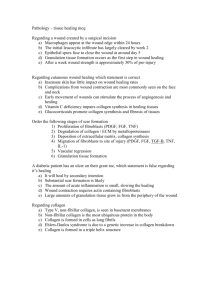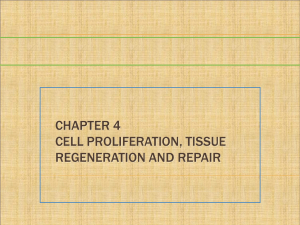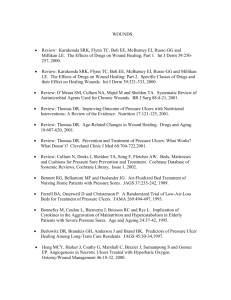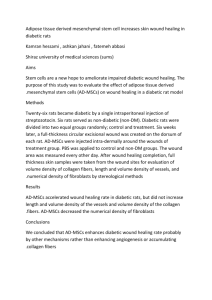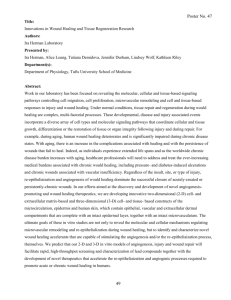Inflammation and Repair - King Saud University Medical Student
advertisement
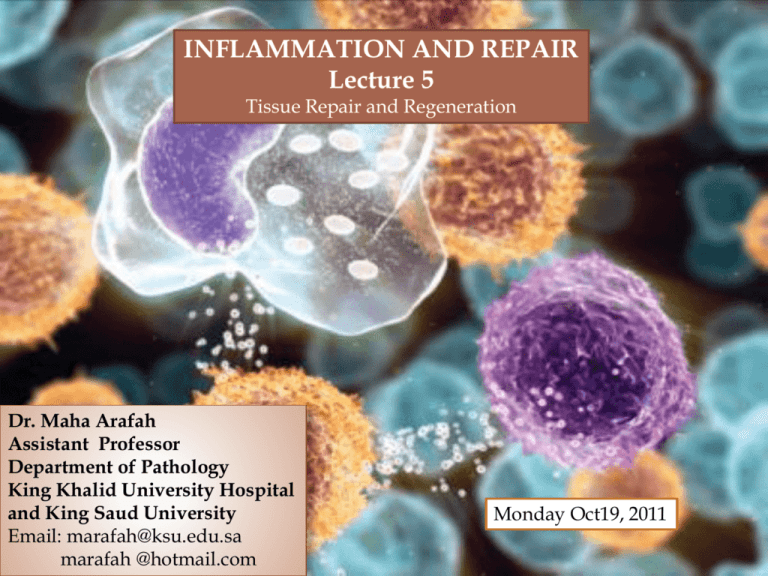
INFLAMMATION AND REPAIR Lecture 5 Tissue Repair and Regeneration Dr. Maha Arafah Dr. Maha Arafah Assistant Professor Department of Pathology King Khalid University Hospital and King Saud University Email: marafah@ksu.edu.sa marafah @hotmail.com Monday Oct19, 2011 1 Upon completion of this lecture, the student should: 1. 2. 3. 4. 5. 6. Describe the differences between the various cell types (ie, labile, stable, and permanent cells) in terms of their regeneration potential. List examples of each cell type. Know the factors that are most important in determining whether regeneration will restore normal tissue architecture. List the three main phases of cutaneous wound healing. Compare and contrast the difference between healing by primary intention and healing by secondary intention. List factors which are associated with delayed wound healing. List complication of wound healing. 2 to restore the tissue to its original state after inflammatory reaction Some tissues can be completely reconstituted after injury, such as the repair of bone after a fracture or the regeneration of the surface epithelium in a cutaneous wound. For tissues that are incapable of regeneration, repair is accomplished by connective tissue deposition, producing a scar. If damage persists, inflammation becomes chronic, and tissue damage and repair may occur concurrently. Connective tissue deposition in these conditions is usually referred to as fibrosis. Labile cells: continue to proliferate throughout life : squamous, columnar, transitional epithelia; hematopoitic and lymphoid tissues Stable cells: retain the capacity of proliferation but they don’t replicate normally: parenchymal cells of all glandular organs & mesenchymal cells Permanent cells: cannot reproduce themselves after birth: neurons, cardiac muscle cells Healing is usually a tissue response (1) to a wound (commonly in the skin) (2) to inflammatory processes in internal organs (3) to cell necrosis in organs incapable of regeneration Repair begins early in inflammation. Fibroblasts and vascular endothelial cells begin proliferating to form a specialized type of tissue (hallmark of healing): granulation tissue • The term granulation tissue was used by ancient surgeons for the red, granular tissue filling the non healing wounds • With the advent of microscopy, it was discovered that granulation tissue occurs in all wounds during healing, and it may occur in chronic inflammation • It consists of: 1. fibroblasts surrounded by abundant extracellular matrix 2. newly formed blood vessels 3. scattered macrophages and some other inflammatory cells. Cleanup of debris, fibrin, and other foreign material at the site ofrepair. Macrophages recruit other cells: fibroblasts and angioblasts Stimulation of matrix production , interleukins that stimulate fibroblasts and angioblasts to produce the extracellular matrix. Remodeling of the scar. They secrete collagenases Migration of fibroblasts to the site of injury and their subsequent proliferation are triggered by multiple growth factors, including TGF-β, PDGF, EGF, FGF, and the cytokines IL-1 and TNF This lead to: 1. 2. increased synthesis of collagen and fibronectin decreased degradation of ECM by metalloproteinases As repair continues, the number of proliferating endothelial cells and fibroblasts decreases. Net collagen accumulation, however, depends not only on increased collagen synthesis but also on decreased degradation. As early as 24 hr. after injury, fibroblasts and vascular endothelial cells begin proliferating to form (by 3-5 days) granulation tissue - pink soft granular appearance on the surface of the wound. New granulation tissue is often edematous. •histologically : granulation tissue is composed of : •proliferation of new small blood vessels and •proliferation of fibroblasts Angiogenesis Angiogenesis from Endothelial Precursor Cells Further healing: increased collagen, decreased active fibroblasts and new vessels(thrombosis and degeneration) At the end: scar (inactive fibroblasts, dense collagen, fragments of elastic tissue, extracellular matrix, few vessels). Three processes that participate in the formation of a scar: (1) emigration and proliferation of fibroblasts in the site of injury (2) deposition of ECM (3) tissue remodeling. Slide 4.19 W.B. Saunders Company items and derived items Copyright (c) 1999 by W.B. Saunders Company 1. Primary union (healing by 1st intention) •clean surgical incision •no significant bacterial contamination •minimal loss of tissue •clot, scab formation 2. Secondary union (healing by 2nd intention) • more extensive loss of cells and tissue: -infarction -inflammatory ulceration -abscess formation •surface wound with large defect •large tissue defect that must be filled 24 hr.: hematoma & neutrophils, mitotic activity of basal layer, thin epithelial layer day 3: macrophages, granulation tissue day 5: collagen bridges the incision, epidermis thickens 2nd week: continued collagen and fibroblasts, blanching End of 1st month: scar (cellular connective tissue, intact epidermis, lost appendages). Later, collagen type III is slowly replaced by collagen type I and the wound acquires tensile strength. By the end of third month, the tissue has approximately 80% of its original strength. Secondary union (healing by 2nd intention) It occur in large, gaping wounds, as well those that are infected or contain foreign material The basic process of healing is the same in all wounds. In contrast to healing by primary intention, wounds healing by secondary intention Require more time to close because the edges are far apart Show a more prominent inflammatory reaction in and around the wound Contain more copious granulation tissue inside the tissue defect wound contraction (5 to 10%), ?myofibroblasts Infection Foreign bodies in the wound Mechanical factors Nutritional deficiencies Excess corticosteroids Complications in wound healing can arise from abnormalities in any of the basic components of the repair process. These aberrations can be grouped into three general categories: (1) deficient scar formation (2) excessive formation of the repair components (3) formation of contractures. Wound dehiscence Keloid Wound ulceration Contracture Keloids are hyperplastic scars composed of irregularly deposited collagen. They may appear as bulging masses. The various cell types (ie, labile, stable, and permanent cells) affect the outcome of healing. Three main phases of cutaneous wound healing: (1) inflammation, (2) formation of granulation tissue, and (3) ECM deposition and remodeling Healing by primary intention occur in surgical clean wound and healing by secondary intention occur when excessive tissue damage is present. Several factors are associated with delayed wound healing. Complication of wound healing include failure of healing, contracture and excessive scar formation.
